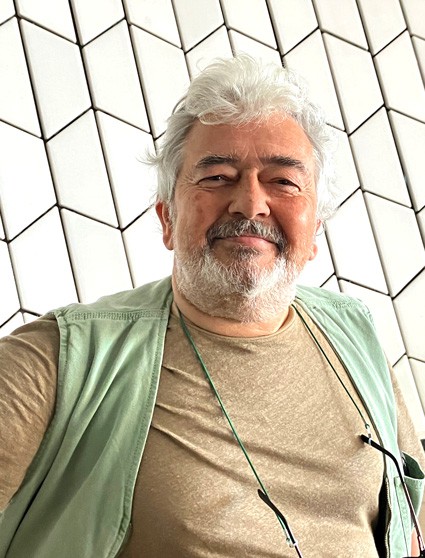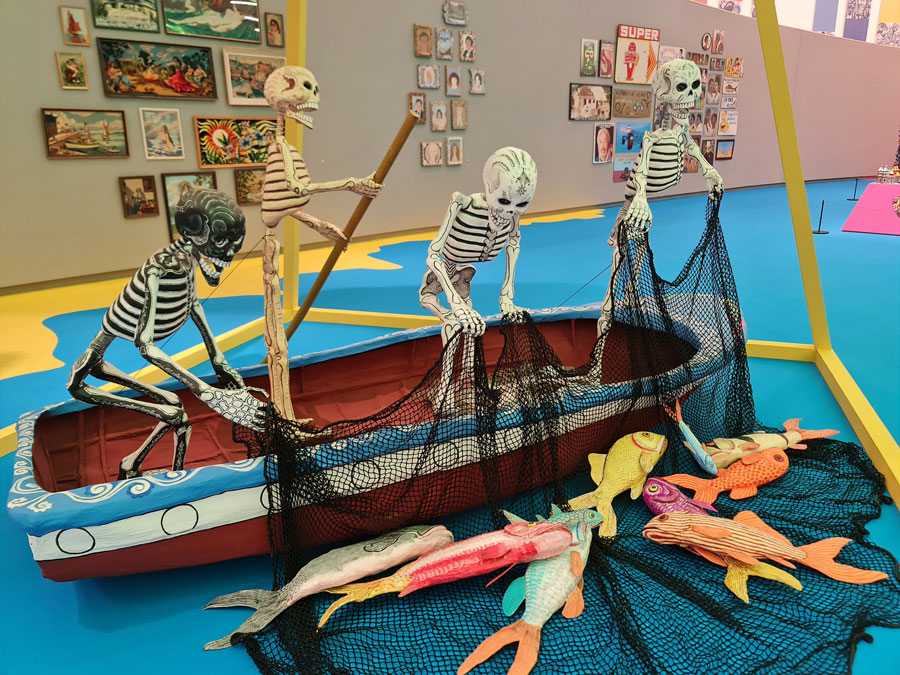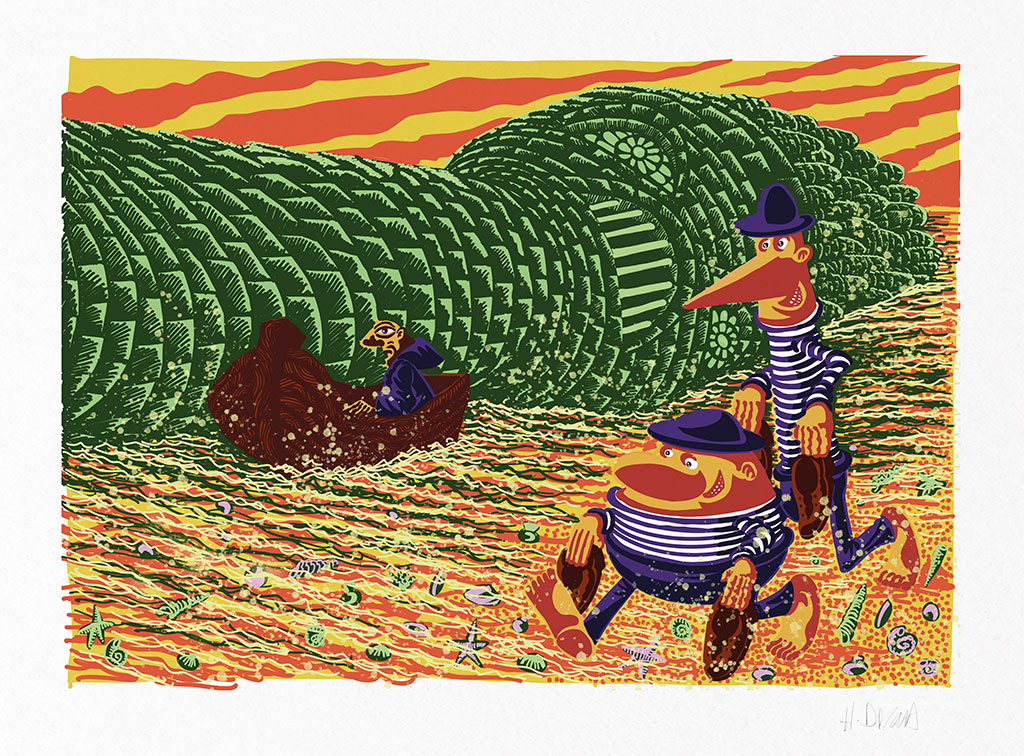
Herve Di Rosa
Interview
Recognized French artist, Hervé di Rosa was born in Sète in 1959. He was a student at the National School of Decorative Arts and at the age of twenty he was already a student. He exhibited his work in Paris, Amsterdam and New York. In 1981 he founded the Free Figuration movement with Robert Combas, François Boisrond and Rémi Blanchard. He was also the inventor of the notion of “modest art” which led to the opening in 2000 of the MIAM - International Museum of Modest Arts in Sète.
Since 1978 he has sought local, artisanal artistic knowledge, undertaking many trips on what he called Autour du Monde . He was in Vietnam learning how to work lacquer, and in Cameroon, pearl, wood and bronze. Tunia, Bulgaria, Ghana, South Africa, Mexico, Israel, among others, are some of the countries where he has been learning from artisans. Since 2016, and carrying out its 19th year trip, he has been in Portugal and at Viúva Lamego to deepen his knowledge of ceramics and tiles. In this way, the artist diversifies his artistic approaches, adding new techniques to his own, where he crosses painting, sculpture, installation, comics and elements of pop culture, graffiti and African art.
Since 1981, he has held more than 250 solo exhibitions and is in the process of developing African art. represented in large public and private collections in Europe, the Americas and Asia. Currently on view at MAAT - Museum of Art, Architecture and Technology, the exhibition "Archipelago Hervé di Rosa" which displays works from the MIAM collection. Until September 4th, not to be missed .
On the occasion of the exhibition in Portugal and the new screen printing carried out for the CPS in the context of the event, we interviewed the artist.
p>
For those who visit the exhibition "Archipelago Hervé di Rosa” is overwhelmingly surprised by the diversity of visual creative universes. The question immediately arises as to how the artist achieved so much. However, we must start at the beginning. How did you start your artistic journey?
I've always drawn. When I was still very young, I thought I would rather go to the comics or illustrations that were the only images that existed in Sète, the small town where I was born and where I lived until I was born. when I was 18 years old. These illustrated magazines had a huge influence on me. As a teenager, art magazines took the place of comic magazines.
What was happening at the end of the 1970s in galleries and museums in France was of little interest to me. I needed images and the act of painting was a pleasure. Conclusion my bachelor's degree at Lycée Paul Valéry in Sète. Then I did a preparatory year at the Beaux Arts de Sète and finally I was admitted to the National School of Decorative Arts in Paris. After two years at this school, I started selling and exhibiting! My first solo exhibition was in 1981, at the age of 21. Two years later I went to New York thanks to my help. Villa Medici award scholarship. And the exhibitions continued until today.
What is the relevance of the Free Figuration movement that you helped to create? to create?
In the late 1970s, the art world was dominated by conceptual art, minimalist art or, in France, the “Support Surface” movement. We were a group of friends who came out of art schools, we were tired of these predominances, and we also all loved comics, illustration, brut art, expressionism, etc. We also wanted to live off the production of our images, without being subsidized by the State or being teachers at an art school, which was somewhat the future of artists in France at that time. We had the intelligence to regroup, for just a few years, the time to impose other points of view on an art world that, in our view, was completely sclerotic at that time.
Spirituality, metamorphoses, outsiders or cordel literature are some of the centers of the exhibition "Archipelago Hervé di Rosa”. Can you give a brief summary of it?
For the exhibition at MAAT, we tried, with my MIAM team and the curator Noellig le Roux, summarize the collection work that I do, and that MIAM has undertaken for decades. Modest arts combine all the margins and peripheries of the different territories of creation. Our Collections seem eclectic, but they have in common the artists, often anonymous artisans who produce images and objects, works of art or crafts, who seek out of necessity to do the best. Often useless objects and images that aim to beautify everyday life, enrich it. It could be those little books sold on the streets of Brazilian cities that contain lyrics to popular songs, under beautiful woodcut covers. They can be deities from the many religions of the earth, in plastic, wood or ceramic, plastic figurines, representing characters from television series or highly successful films, published in thousands of copies. It may be the invisible production of an artist, hidden, who does not wish to be exposed. Modest art is all this and much more. Modest art brings together everything that we don’t look at, modest art is a new look at the objects and images that surround us.

"Archipelago Hervé Di Rosa", exhibition on display at MAAT, in Lisbon, until the end of the year. September 4, 2023.
With one of the islands affectionately dedicated to the work of Your father, what is his influence on your work?
Throughout my childhood, I saw my father, afternoon - his only leisure time apart from hunting and fishing, and his work at night at the French railway company – He meticulously made, in wood and cork, reproductions of waterfowl and shorebirds that he hunted. Thau lakeside. Then he glued the glass eyes, assembling real bird feet with pieces of wire on the cork body, finely sculpted and painted with oil paint. For the child I was, these creatures were born from their own hands, it was magical! I didn't go to museums, which didn't exist in my city, and these cork sculptures were without a doubt my first artistic sensations. There are It's been a long time since my father couldn't do more and I keep this collection with great affection, which I frequently show in my exhibitions.
How do you see the role of the craftsman and the workshop in a world dominated by technology?
Many pieces in the MIAM collections come from artisans. I myself have already I worked with many artisans from all over the world in my Autour du Monde project, to learn how to use certain techniques that I was unaware of: lacquer in Vietnam, bronze in Cameroon or ceramics in Portugal for example. I love experimenting with materials and techniques and artisanal practices give an infinite world of possibilities. But I don't want to get into the wrong debate and I don't necessarily defend traditions. I'm interested in learning techniques that sometimes disappear, such as the tempera painting technique on wood that icon painters used years ago. several centuries. But I'm also very interested in new technologies, laser printers, drawing and painting programs. In fact, the current exhibition at MIAM “fait machine” is dedicated to young artists who use these new technologies, but in a very artisanal way and using materials such as earth, wool and wool. or glass. New imaging technologies are of great interest to me. For example, I'm very interested in everything that happens in video games, where I find breathtaking creativity.

" Archipelago Hervé Di Rosa", exhibition on display at MAAT, in Lisbon, until the end of the year. September 4, 2023.
Tell us about your travels across all the hemispheres, within the scope of Autour du Monde, and the most recent one to Portugal, where you have lived for the last year. for several years.
At the end of the 80s, I felt a certain tiredness of my studio. Before, I traveled a lot throughout the United States and Europe, while entire continents were still unknown to me. As I hate traveling for sightseeing, I traveled to learn. I noticed that the world was rich in the creation of objects and images. And that the techniques used, whether ancestral or contemporary, defined and determined the object or image created, giving it an originality and an unparalleled flavor. Above all, I try to change my own language, twist it, make it interpreted by other hands, by other materials. I want to use ancestral techniques, such as tempera painting, but also techniques related to new materials, for example in South Africa, with large pieces braided into colored telephone cables . Often, the urgency of the situation and necessity lead human beings to invent completely unexpected forms of art. We are in a world of continually renewed images and these images are not only those revealed by our screens, but also those created in rural villages. roadsides or in the suburbs of the world's megacities. I didn't expect to spend so much time in Portugal when I came to learn ceramics. But this technique and the factory where I work offer me so many possibilities that I have been practicing this technique for several years. seven years and I still haven't finished.
"Art cannot be divorced from Nature", can be read in the exhibition. In a moment of euphoria with the valences of Artificial Intelligence, what is the relevance of this statement?
The quote is from my friend, Kwame Akoto dit Almighty God, a Ghanaian artist who made my portrait and who painted this quote above my face. I must say that this quote is a bit mysterious to me But I'm sure he's right, because this artist is also a great philosopher. For me, nature is also art and the painter is also a philosopher.< /p>
What is the role of art, or different forms of art, in today's society?
I don't know anymore! Perhaps we would like art to be widespread, to enter homes, for the world to be inhabited only by art lovers, even modest ones, and for the world was led by artists. Unfortunately, these days, art is in short supply. increasingly reserved for an elite that is increasingly rich and distant from reality. The market completely disconnects creation from reality. And the current view we have of this is; totally distorted. Big brands buy artists and museums are subsidized by big brands. In the 80s, the luxury industry took over contemporary art and we made a toy for rich heirs! Now I don't quite understand what's happening. It's happening, but I know there's something wrong with it. There is a lot of resistance in collective projects, artists who come together and decide to work in a different way, exhibit differently. MIAM is part of this culture of resistance.
With a vast personal work and a Is it a remarkable museum with thousands of works where the artist ends and the collector begins?
I'm just an artist who collects and who can have something like an infinite source in his collections. É like in comics, I've never done it, I can't do it, it's just a matter of fact. very tedious for me. But I'm a big fan, a big collector of comic books, from which I also draw a lot of inspiration.
< span style="color: #c2a476;">We understand the edits made at CPS as collaborative and humanized, what is the importance of the graphic work and the multiple of art in your work?
When I was 14 years old, it wasn't exhibitions I wanted to do, but books, printed paper, printing paper, newspapers, fanzines , magazines, engravings. I wanted original images and not reproductions, but to be distributed to as many people as possible. Printing techniques have always fascinated me, from copper engraving, which requires a lot of work, a lot of practice, to printing. to engraving on card which is It is ephemeral and of which only a few copies are made. Today I also like making books for bibliophiles. I recently produced a book about the texts of Savinien Cyrano de Bergerac, which mixes lithography and screen printing. É It is a great luxury to be able to work with professionals from these different printing techniques, on large projects that demand a lot of resources. But a photocopied fanzine also interests me. I must have made 250 books and catalogs and hundreds of engravings and silkscreens. And I continue to be passionate about these techniques. In this context, I have also used contemporary techniques with graphic programs, images entirely created on the iPad, whose original is, ultimately, a code.
"Íidolo cado”, screen print that Hervé di Rosa created for the CPS, in the context of its exhibition at MAAT (56 x 76 cm, 150 copies).
Tell us about the screen printing now edited and which marks the relevant exhibition at MAAT .
This is the first screen print in the "idols" series. Over the last few years, I have been working on paintings where two wandering friends walk through the ruins. in the imaginary, an invisible archaeology. They are often large buildings, shaped like idols with many eyes and many limbs. In this work, our wandering friends come across an idol stranded on the shore, the ruin of an ancient forgotten civilization, a proud civilization that has now disappeared.
< p>
With art in the open field, what do you recommend to the collecting members of the Portuguese Screen Printing Center?
Now when we choose a work of art, it is It's good to get advice from experts or read some specialized magazines. Our tastes are not necessarily the best and I am very cautious with mine. In any case, when purchasing screen prints or engravings, I advise you to always buy original graphic work. This is because many reproductions circulate that are nothing more than simple signed posters. There are so many different artists represented by the Portuguese Screen Printing Center that I am amazed. It's very difficult to choose. My advice: buy everything.
Interview by Antônio and João Prates, July 2022
